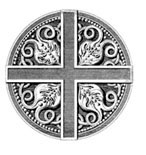
At the Tomb of St. Thérèse
THE LITTLE FLOWER AND THE GREAT WAR
Onboard the night train to Lisieux, the fat old woman opposite me smokes and talks non-stop, distraughtly passing her butts to the stranger next to her for disposal. Her husband died of cancer three weeks ago, after 42 years of marriage and six children. Madagascar, then a French colony, was the beautiful island home of her youth and where she yearns to go to die. She curses Socialists, who, she says, have ruined France, and praises whiskey, her consolation in sorrow. Miles pass and she asks about me. I say I am en route to Lisieux to pay gratitude to St. Thérèse. “Are you Catholic?” Yes, a convert. She pauses, then crisply intones, “You are Peter and on this rock I will build my Church,” followed by silence, then a parting “God bless you.”
I am bound for the Carmelite convent at Lisieux, France, where St. Thérèse of the Child Jesus and the Holy Face is buried, and where millions come to pay homage. We come for a nun who died a little over a century ago and who was thought so unimportant in her day that her newspaper obituary ran a single line: “Death on 30 September, of Marie Françoise Thérèse Martin, 24 years 9 months, nun at Carmel, rue de Jivarot.” All of 35 persons attended her funeral. Yet over 900 biographies have since been written about Thérèse Martin. Pope Pius XII dedicated the Vatican gardens to her patronage. Pope John Paul II named her a Doctor of the Church. And she has impacted countless lives. In the 1920s, New York radical Dorothy Day read her autobiography and converted to Catholicism. That same decade a young Albanian entered religious life in Thérèse’s name — the future Blessed Teresa of Calcutta.
But my route is first via Paris and then Bordeaux, where I will catch unexpected glimpses of the famous saint known as the Little Flower. In Paris I make the compulsory visit to Notre Dame Cathedral. The secular-minded French government owns and maintains all churches built before 1905 as national monuments, but leaves the preaching inside to Catholic priests. Signs and literature explain Catholic beliefs to the waves of tourists. Little Sisters of the Poor, in full habits, collect money for the needy. Priests in glass-walled confessionals offer absolutions in multiple languages. I confess and make my penance before a side altar dedicated to St. Thérèse.
In Paris I also visit the convent where in 1830 the Blessed Mother commissioned St. Catherine Labouré to create the Miraculous Medal, a pendant reading, “O Mary Conceived Without Sin, Pray for Us Who Have Recourse to Thee.” Here I first glimpse another phenomenon I’ll find in Lisieux — the Holy Spirit has made Africa His new home! Serious young black Francophone Africans fill the chapel. Before Mass one sneaks onto the off-limits altar in order to kiss the glass case containing St. Catherine’s incorrupt body. Four priests concelebrate Mass, two white, two black, preaching a homily which jointly extolled Thérèse of Lisieux and Blessed Teresa of Calcutta because both thirsted for the salvation of souls.
Departing Paris I arrive in Bordeaux. Fewer than 100 souls were inside Bordeaux’s St. André’s Cathedral for its main Sunday Mass. On this site in 1096 Pope Urban II preached the First Crusade and extolled France’s large population as a gift from God to fight Islam. Some 900 years later, France has embraced sterility, Islam lives by the principles of Humanae Vitae, and Muslims fill the demographic void of western Europe. Three mosques sit within a few minutes’ walk from where Urban preached, and Muslims make up some 70 percent of the students at Catholic schools in France. St. André’s was turned into a barn during the French Revolution and stripped of adornment. Many side chapels remain empty even today, save for a lone statue. In the gloom I mistake St. Bernadette for St. Thérèse. An elderly woman redirects me one chapel over. There are no votive candles burning here, very unusual for a Thérèsian altar. I buy and light a tall taper, then recite prayers to this saint.
You May Also Enjoy
Croatia's cardinal Stepinac faced opposition unimaginable to most prelates in the modern West. By all indications, he did not buckle.
One country has kept Catholicism in the attic for centuries. The other has kept Catholicism alive, even on uninhabited islands.
In Poland the presumption is that truth is one, and there is only the true Church. If it's not Catholic, it's not true. The spiritual maze is simple to navigate.

